A&D EJ-2000, EJ-610, EJ-1500, EJ-4100, EJ-440 User Manual
...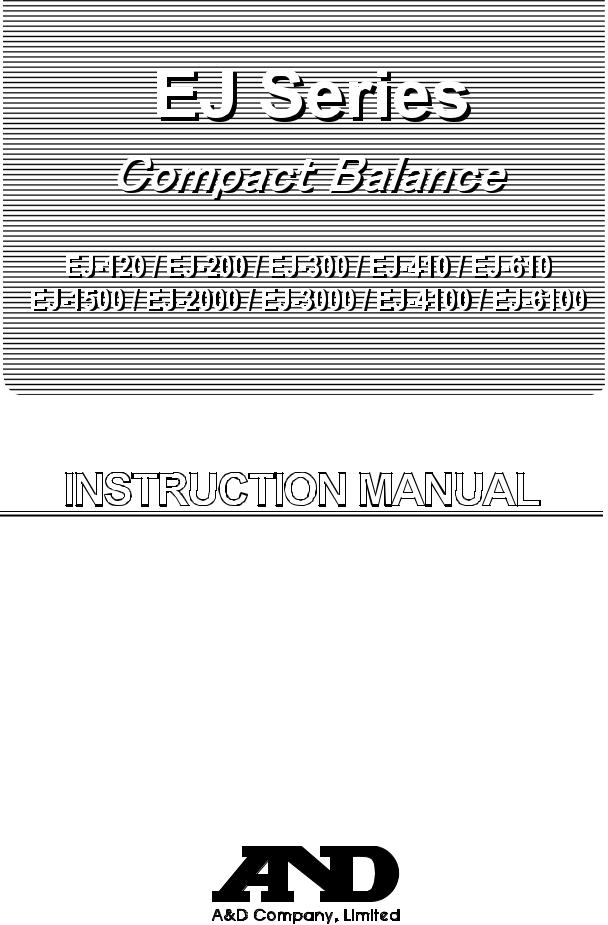
1WMPD4001917

This manual and Marks
All safety messages are identified by the following, “WARNING” or “CAUTION”, of ANSI Z535.4 (American National Standard Institute: Product Safety Signs and Labels). The meanings are as follows:
WARNING |
A potentially hazardous situation which, if not avoided, could result |
|
in death or serious injury. |
||
|
||
CAUTION |
A potentially hazardous situation which, if not avoided, may result in |
|
minor or moderate injury. |
||
|
This is a hazard alert mark.
Note This manual is subject to change without notice at any time to improve the product. No part of this manual may be photocopied, reproduced, or translated into another language without the prior written consent of the A&D Company.
Product specifications are subject to change without any obligation on the part of the manufacture.
Compliance with FCC rules
Please note that this equipment generates, uses and can radiate radio frequency energy. This equipment has been tested and has been found to comply with the limits of a Class A computing device pursuant to Subpart J of Part 15 of FCC rules. These rules are designed to provide reasonable protection against interference when this equipment is operated in a commercial environment. If this unit is operated in a residential area it might cause some interference and under these circumstances the user would be required to take, at his own expense, whatever measures are necessary to eliminate the interference. (FCC = Federal Communications Commission in the U.S.A.)
Copyright
 2009
2009 











CONTENTS
1. INTRODUCTION ............................................................................................................. |
3 |
2. UNPACKING ................................................................................................................... |
3 |
3. PART NAMES AND FUNCTIONS................................................................................... |
4 |
4. SETTING UP ................................................................................................................... |
5 |
4-1. Setting up your balance ................................................................................................................. |
5 |
4-2. Power source................................................................................................................................. |
5 |
4-3. Breeze break ................................................................................................................................. |
6 |
4-4. Storage .......................................................................................................................................... |
6 |
5. OPERATION.................................................................................................................... |
7 |
5-1. Turn the power ON and OFF ......................................................................................................... |
7 |
5-2. LCD backlight ................................................................................................................................ |
7 |
5-3. Units .............................................................................................................................................. |
8 |
5-4. Selecting a weighing unit ............................................................................................................... |
9 |
5-5. Basic operation.............................................................................................................................. |
9 |
5-6. Counting mode (pcs) ................................................................................................................... |
10 |
5-7. Percent mode (%)........................................................................................................................ |
11 |
6. COMPARATOR ............................................................................................................. |
12 |
6-1. Setting example........................................................................................................................... |
12 |
7. CALIBRATION .............................................................................................................. |
14 |
7-1. Calibration using a weight............................................................................................................ |
14 |
7-2. Gravity acceleration correction .................................................................................................... |
16 |
8. FUNCTIONS.................................................................................................................. |
17 |
8-1. Key operation .............................................................................................................................. |
17 |
8-2. Entering the function setting mode .............................................................................................. |
17 |
8-3. Setting example........................................................................................................................... |
18 |
8-4. Storing weighing units.................................................................................................................. |
19 |
8-5. Function list ................................................................................................................................. |
20 |
9. OPTIONS....................................................................................................................... |
22 |
9-1. EJ-02 USB Interface.................................................................................................................... |
22 |
9-2. EJ-03 RS-232C serial interface ................................................................................................... |
22 |
9-3. EJ-07 / EJ-08 Underhook ............................................................................................................ |
26 |
9-4. EJ-11 Breeze break ..................................................................................................................... |
26 |
9-5. EJ-12 Carrying case .................................................................................................................... |
26 |
9-6. EJ-13 Density Determination Kit.................................................................................................. |
27 |
10. ID NUMBER AND GLP................................................................................................ |
30 |
10-1. Setting the ID number................................................................................................................ |
30 |
10-2. Output example ......................................................................................................................... |
31 |
10-3. Calibration test using a weight................................................................................................... |
32 |
1
11. MAINTENANCE .......................................................................................................... |
34 |
|
11-1. |
Notes on maintenance ............................................................................................................... |
34 |
11-2. |
Error codes ................................................................................................................................ |
34 |
12. SPECIFICATIONS ....................................................................................................... |
36 |
|
12-1. |
EJ series .................................................................................................................................... |
36 |
12-2. |
Other weighing units .................................................................................................................. |
37 |
12-3. |
Options ...................................................................................................................................... |
38 |
12-4. |
Dimensions................................................................................................................................ |
38 |
GRAVITY ACCELERATION MAP ..................................................................................... |
39 |
|
2
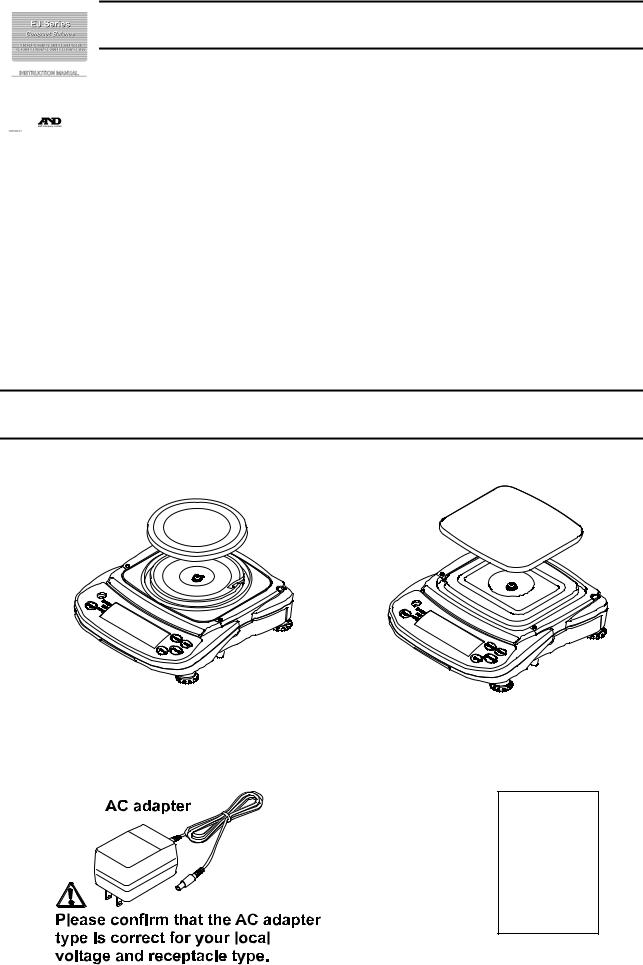
1. INTRODUCTION
This manual describes how this balance works and how to get the most out of it in terms of performance.
EJ series balances have the following features:
The EJ series are high-resolution type electronic balances having a display resolution of 1/12,000 ~ 1/60,000.
The balance has a counting function, % function and a comparator function.
The backlight LCD will help with use in a dimly lighted place.
The balance can be operated with an AC adapter, or 4 x “AA” size dry-cell batteries for cordless operation.
The optional RS-232C serial interface can be connected with a printer or personal computer, and Good Laboratory Practice (GLP) data can be obtained.
The optional USB interface is available to connect with a personal computer easily.
2. UNPACKING
When unpacking, check whether all of the following items are included:
Weighing pan |
Weighing pan |
Main unit |
Main unit |
||
EJ-120 |
/ EJ-200 / EJ-300 |
EJ-1500 |
/ EJ-2000 / EJ-3000 |
EJ-410 |
/ EJ-610 |
EJ-4100 |
/ EJ-6100 |
Instruction Manual
3
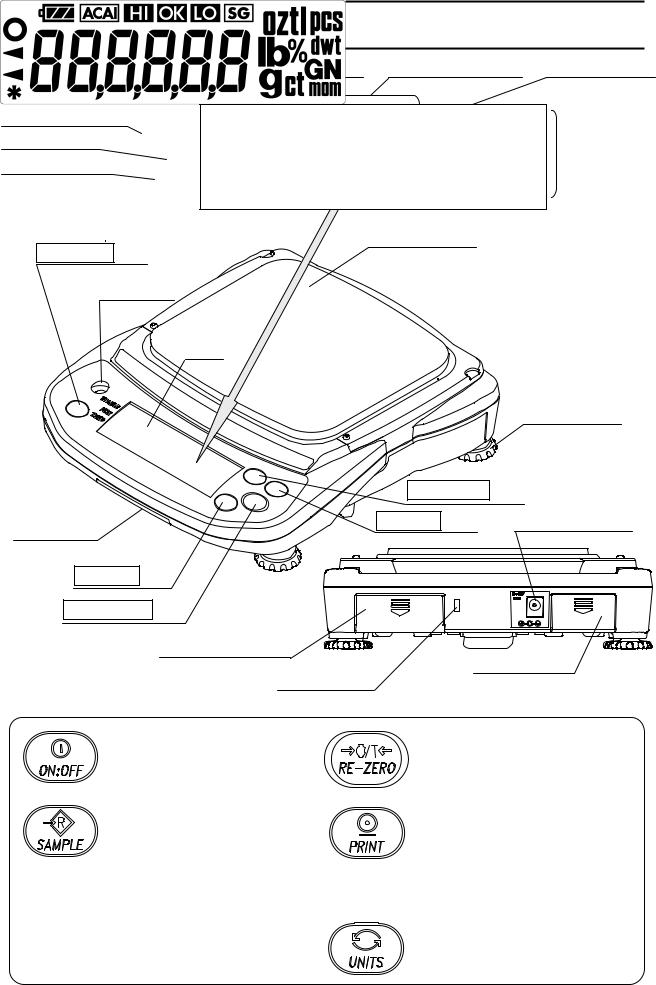
3. PART NAMES AND FUNCTIONS
|
Battery indicator ACAI indicator |
Comparator results Specific gravity |
STABLE indicator |
|
|
NET indicator |
STABLE |
Weighing |
|
NET |
|
ZERO indicator |
units |
|
|
ZERO |
|
ON:OFF |
key |
Weighing pan |
Round pan for |
||
EJ-120 / EJ-200 / EJ-300 / EJ-410 / EJ-610.
Spirit level
LCD
Leveling foot
Calibration |
SAMPLE |
key |
|
switch cover |
PRINT key |
AC adapter jack |
|
(bottom) |
|||
|
|
UNITS key
RE-ZERO key
EJ-02 / EJ-03 slot
Battery cover
Security slot
(Use a security cable commercially available.)
Turns the power on or off.
Held down to enter the function setting mode.
pcs mode:
Enters the sample unit weight storing mode.
% mode:
Enters the 100% weight storing mode.
Clears the display to zero (combined zero and tare).
Outputs the weight value to printer.
Stores a unit weight, 100% weight or other setting values to the balance.
Switches the weighing units.
4

4. SETTING UP
4-1. Setting up your balance
1.Place the weighing pan on the main unit as shown in “2. UNPACKING”.
2.Adjust the level of the balance using the leveling feet. Use the spirit level to confirm. The bubble should be in the center of the circle.
3.Calibrate your balance before use. (See “7. CALIBRATION”)
Balance location
To measure correctly, to keep the balance in good condition, and to prevent hazards, observe the following:
Do not install the balance in locations that are subject to excessive dust, breezes, vibration, large temperature fluctuations, condensation, or that may have magnetic fields.
Do not install the balance on a surface that is soft or that may cause the balance level to shift.
Do not install the balance in direct sunshine.
Do not install the balance near heaters or air conditioners.
Do not use an unstable AC power source.
Do not install the balance in a place where combustible or corrosive gases may exist.
Allow the balance to reach equilibrium with the ambient temperature before use.
Switch the power ON at least half an hour before use so that the balance can warm up.
When the balance is installed for the first time, or the balance has been moved, carry out calibration as described in “7. CALIBRATION”
4-2. Power source
For the power source, the AC adapter or 4 x “AA” size dry-cell batteries can be used.
When using the AC adapter |
AC adapter jack |
Use a stable power source. To use the AC adapter, |
|
insert the AC adapter plug into the AC adapter jack |
|
on the rear side of the EJ. |
|
When using the dry-cell batteries
Prepare 4 x AA size (LR6 / R6P) dry cell batteries. The batteries are not included in the product,
 CAUTION
CAUTION
Take great care of the polarity of batteries. The polarity marks are shown in the battery box.
Replace used batteries with four new ones when “lb0” is displayed.
Do not mix used and new batteries. Do not mix the battery type. It may cause damage to the batteries and the balance.
The battery life depends on the ambient temperature, how to use and so on.
5
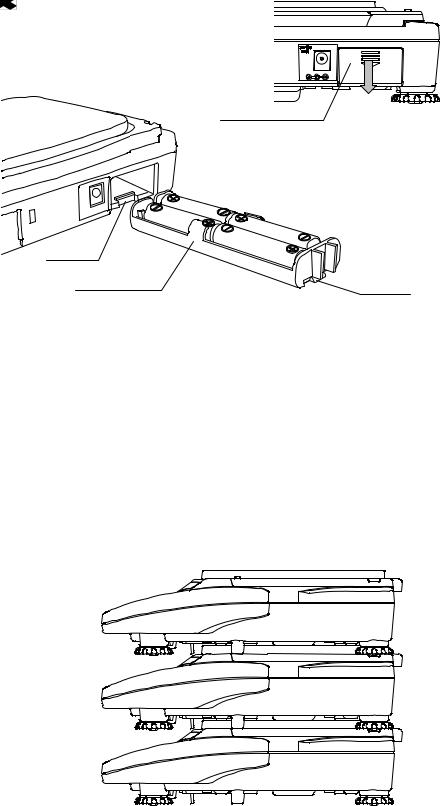
Remove batteries when the balance is not to be used for a long time. They may leak and cause damage to the balance.
Damage due to battery leakage is not covered by the warranty.
Installing batteries
1.Turn off the balance and disconnect the AC adapter if used.
2.Slide the battery cover off.
3.Push the battery box up to unhook and pull it out.
4. Insert new four batteries (LR6 / R6P / AA size) into the battery box, taking extreme care of the polarities.
5.Push the battery box into the balance as before.
6.Attach the battery cover.
Battery cover
Hook
Battery box |
Hook |
Battery indicator turns on when the balance is operated by the batteries. It will change as the battery voltage decreases.
New  Æ
Æ  Æ
Æ  Æ
Æ  Coming close to “lb0”.
Coming close to “lb0”.
4-3. Breeze break
The optional breeze break is available. See “9-4. EJ-11 Breeze break”.
4-4. Storage
The EJ series balance can stack on top of another when not in use.Do not stack more than 3 units.
6
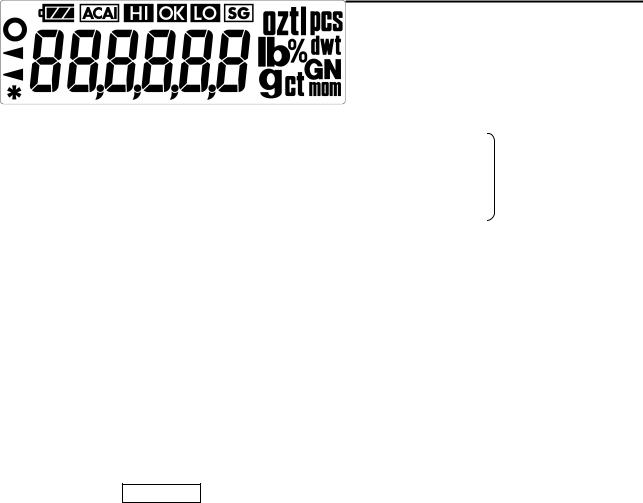
|
|
|
5. OPERATION |
|
5-1. Turn the power ON and OFF |
||||
1. Press the |
|
|
key to turn the power ON. |
|
ON:OFF |
||||
|
|
|
||
STABLE |
|
|
Weighing |
|
NET |
|
|
||
|
|
units |
||
ZERO |
|
|
|
|
|
|
|
|
|
All of the symbols are displayed as shown above. (About units: Only the units available will be displayed.)
The display turns off except for a weighing unit and the decimal point.
The balance waits for the weighing data to become stable, and zero will be displayed with the ZERO indicator (power-on zero).
The range for power-on zero is within ±10% of the weighing capacity around the calibrated zero point.
If the power is switched ON while there is a load beyond this range, the balance will be tared to zero and the NET indicator and the ZERO indicator turn on.
2. Press the ON:OFF key again, and the power will be switched OFF.
Auto-power off function
It is possible to have the power automatically switched OFF, if zero is displayed for approximately 5 minutes. See “8-5. Function list” and set the function “poff”.
5-2. LCD backlight
The LCD backlight will turn on when the weight value changes more than 4d (4 x min. display division) or any key operation is done. When the weight data becomes and stays stable for some moment, the backlight will automatically turn off. There is also a setting that the backlight is always on or off. For details, see the function setting “ltUp” of “Function list”.
7
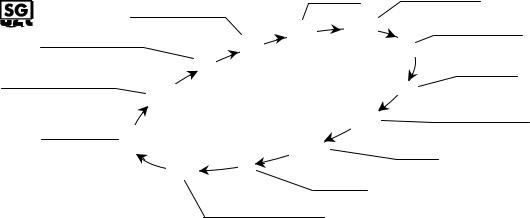
5-3. Units
The most common unit of weight used around the world is the gram, but there is often a need to shift to alternative units specific to the country where the balance is used or to select modes such as counting or percent.
The units and the order they appear in the display are as follows:
Ounce (avoir) |
Pound |
|
Metric carat |
||
Percent mode |
||
|
Momme
Counting mode
Pennyweight
Gram
Grain
Density Newton (specific gravity)
Among the units, those available for the user have been set at the factory before shipping.
The unit can be selected in the function setting mode. The order of the units available is the same as above.
Note
It is possible to store only the units that will be actually used from the units available. It is also possible to specify the display unit that will be shown first when the power is switched ON. For details, see “8-4. Storing weighing units”.
Conversion table
Units |
Name |
Conversion to gram |
oz |
Ounce (avoir) |
28.349523125 g |
lb |
Pound (UK) |
453.59237 g |
ozt |
Troy ounce |
31.1034768 g |
ct |
Metric carat |
0.2 g |
mom |
momme |
3.75 g |
dwt |
Pennyweight |
1.55517384 g |
GN |
Grain (UK) |
0.06479891 g |
t |
tola |
11.6638038 g |
tl |
tael (Hong Kong general, Singapore) |
37.7994 g |
tl |
tael (Hong Kong jewelry) |
37.4290 g |
tl |
tael (Taiwan) |
37.5 g |
“Newton” is the value calculated by “(g value) x (9.80665 m/s2) / 1000”.
The unit “t (tola)” and three kinds of “tl (tael)” are for special versions only. One of them can be selected and installed at the factory.
8
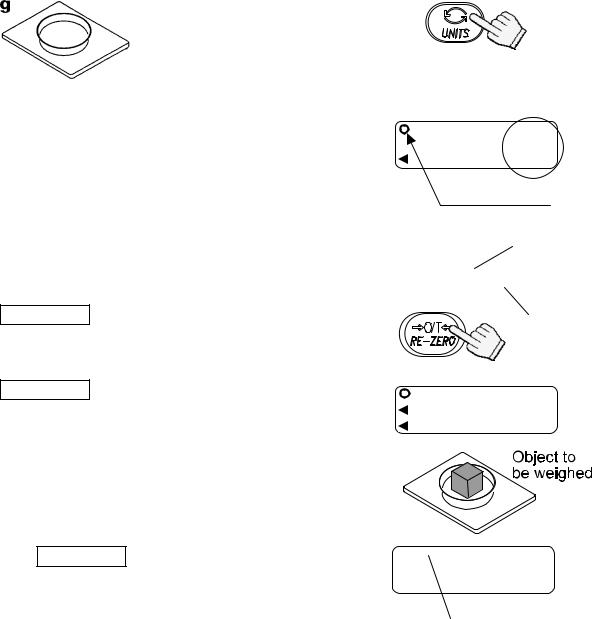
5-4. Selecting a weighing unit
Press the UNITS key to select a unit.
The following sections are a description of the three common units: g (gram mode), pcs (counting mode), and % (percent mode).
Each pressing switches the units available in the order described on the previous page.
5-5. Basic operation
1.Select a weighing unit.
2.When the display does not show zero, press the
RE-ZERO key to set the display to zero.
3.When using a tare (container), place the container on the weighing pan, and press the
RE-ZERO key to subtract the tare weight.
4.Place the object to be weighed on the pan or in the container.
Wait for the STABLE indicator to be displayed and read the value.
5.Remove the object from the pan.
The RE-ZERO key will zero the balance if the weight is within ±2% of the weighing capacity around the power-on zero point. The ZERO indicator  turns on. When the weight exceeds +2% of the weighing capacity, it will be subtracted to zero as a tare weight. In this case the ZERO and NET marks turn on.
turns on. When the weight exceeds +2% of the weighing capacity, it will be subtracted to zero as a tare weight. In this case the ZERO and NET marks turn on.
ZERO |
00. |
|
|
|
STABLE indicator |
Container
Weighing pan
NET |
00. |
ZERO |
|
NET 

 1503.
1503. 
STABLE indicator
 Precautions during operation
Precautions during operation
Make sure that the STABLE indicator is on whenever reading or storing a value.
Do not press the keys with a sharp object such as a pencil.
Do not apply a shock or a load to the pan that is beyond the weighing capacity.
Keep the balance free from foreign objects such as dust or liquid.
Calibrate the balance periodically to keep weighing accuracy. (See “7. CALIBRATION”.)
9
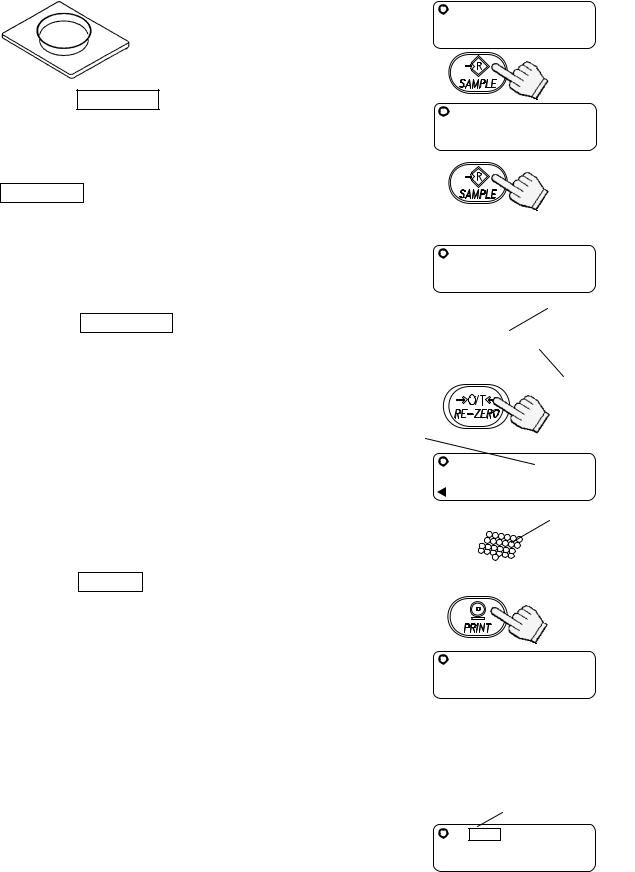
5-6. Counting mode (pcs)
Weighs the sample pieces and calculate its unit weight. Using the sample unit weight, the scale counts the number of parts or items.
As for the minimum unit weight acceptable, see the function setting “Umin”.
Selecting the counting mode
1. Press the |
UNITS |
key to select |
. |
( :pieces)
:pieces)
Storing the sample unit
2.Press the SAMPLE key to enter the sample unit weight storing mode.
3.To select the number of samples, press the
SAMPLE key. It may be set to 5, 10, 25, 50, or 100.
0
10 -
Each pressing switches the number of samples.
|
25 - |
4. Place a tare container on the weighing pan, and |
Container |
press the RE-ZERO key. Confirm that the |
|
right side of the number of samples shows zero. |
|
|
Weighing pan |
Confirm the display |
|
5.Place the number of samples specified on the pan. In this example, 25 pieces.
6.Press the PRINT key to calculate and store the unit weight. Remove the sample. The balance is set to count objects with this unit weight.
ZERO |
25 0 |
|
Samples (25 pcs)
To store
Counting the objects |
25 |
7. Place the objects to be counted on the pan.
Counting mode using the ACAI function
ACAITM (Automatic Counting Accuracy Improvement) is a function that improves the accuracy of the unit weight by increasing the number of samples as the counting process proceeds.
8.If a few more samples are added, the ACAI indicator is displayed. (To prevent an error, add three or more. The ACAI indicator will not be displayed if overloaded.)
ACAI
10
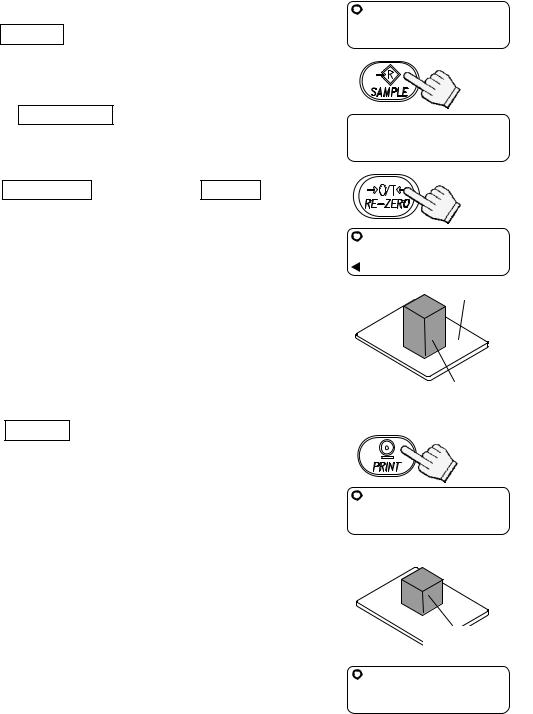
9.The balance re-calculates the unit weight while the ACAI indicator is blinking. Do not touch the balance or samples on the pan until the ACAI indicator turns off.
10.Counting accuracy is improved when the ACAI indicator turns off. Each time the above operation is performed, a more accurate unit weight will be obtained. There is no definite upper limit of ACAI range for the number of samples exceeding 100. Try to add the similar number of samples as displayed.
5-7. Percent mode (%)
Displays the weighing value in percentage compared to the reference (100%) weight.
Selecting the percent mode
1. Press the UNITS key to select %. (%:percent)
Storing the reference (100%) weight
2.Press the SAMPLE key to enter the reference weight storing mode.
00.
 100 -
100 -
%
%
3. Press the RE-ZERO key to display 100 0%.
4. Place the sample |
to be set as the reference |
ZERO |
|
100 0 % |
|
||||
|
Weighing pan |
|||
|
|
|||
weight on the pan. |
|
|
|
|
|
|
|
|
5.Press the PRINT key to store the reference weight. Remove the sample.
Reading the percentage
6.Place the object to be compared to the reference weight on the pan. The displayed percentage is based on 100% of the reference weight.
Sample corresponding to the 100% weight
To store
1000. %
Object to be compared
758. %
11
